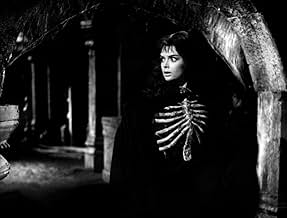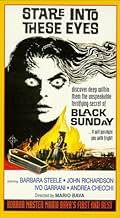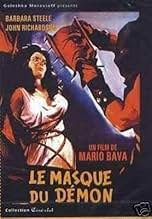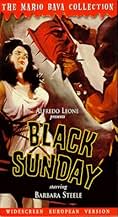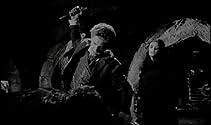IMDb RATING
7.1/10
18K
YOUR RATING
Decades after being executed for witchcraft, vengeful Princess Asa Vajda and her fiendish servant are resurrected and begin a bloody campaign to possess the body of Asa Vajda's beautiful loo... Read allDecades after being executed for witchcraft, vengeful Princess Asa Vajda and her fiendish servant are resurrected and begin a bloody campaign to possess the body of Asa Vajda's beautiful look-alike descendant Princess Katia.Decades after being executed for witchcraft, vengeful Princess Asa Vajda and her fiendish servant are resurrected and begin a bloody campaign to possess the body of Asa Vajda's beautiful look-alike descendant Princess Katia.
- Awards
- 1 win & 1 nomination
Barbara Steele
- Princess Asa Vajda
- (as Barbara Steel)
- …
Giuseppe Addobbati
- Priest
- (uncredited)
Fernando Cajati
- Crucifixion Torturer
- (uncredited)
Valentina Cortese
- Tavern Girl
- (uncredited)
Angelo Galassi
- Tavern Keeper
- (uncredited)
Nando Gazzolo
- Narrator
- (voice)
- (uncredited)
Renato Montalbano
- Spectator
- (uncredited)
Storyline
Did you know
- TriviaMario Bava and Barbara Steele had a difficult working relationship. She sometimes refused to come to set because she did not like her wig or the fact that her cleavage would be shown. One time she refused because she believed Bava would force her to appear nude. She admits that she was difficult due to her inexperience and inability to understand Italian.
- GoofsIn the opening credits, Barbara Steele's name is misspelled as Barbara Steel.
- Quotes
Princess Asa Vajda: You, too, can feel the joy and happiness of hating.
- Crazy creditsFor "The Mask of Satan," the English language version prepared in Italy, Barbara Steele's name is listed as "Barbara Steel" on the trailer and on the credits of the film itself.
- Alternate versionsThe full list of differences between the 83-minute original cut and the 80-minute AIP cut:
- A different English-language dub, and a new score by Les Baxter.
- An added pre-text crawl warning the audience about the film's content: "The producers of the picture you are about to see feel a moral obligation to warn you that it will shock you as no other film ever has. Because it could be very harmful to young and impressionable minds, it is restricted to only those over fourteen years of age."
- Alternate opening credits.
- A brief exchange between Katja and Constantine where he tells her their father has died is cut.
- A scene where Katja and Andrej talk in the garden is cut.
- An exchange between Katja and Andrej outside her room is cut.
- Kruvajan's death scene is cut down significantly to remove shots of his eye spurting blood.
- The scene were Prince Vajda reanimates and menaces Katja is trimmed.
- Vajda's death scene, particularly the close-ups of his head melting, is trimmed.
- Asa taunting Andrej before being burned at the stake is cut.
- Added closing credits.
- ConnectionsFeatured in I motorizzati (1962)
Featured review
A ruined abbey; Gothic interiors of a medieval crypt and castle; a matte painting of the moon illuminating the castle's exterior; a deep pit, the stonework glistening with moisture; claw-like branches against the white mist, all beautifully photographed for shadowy effect by master cinematographer Mario Bava, make this film worth watching. The thin plot involves two incestuous siblings, Asa and Javutich Vajda, executed for witchcraft in the Balkan kingdom of Moldavia, who return from the grave on Walpurgis night two centuries later to reek supernatural vengeance on their descendants.
Unfortunately the B&W beauty of this movie is compromised somewhat by Bava's awkward direction of actors whose performances range from adequate (Andrea Checci as Dr. Kruvaijan, and Ivo Garrani as Prince Vajda) to inept (Barbara Steele as both Princess Katia Vajda and Asa Vajda), to awful (John Richardson as Dr. Gorobec). The writing is likewise sub-par, and seems to borrow elements from the vintage American films "Mark of the Vampire" and "The Black Room," which Bava may have seen.
Plot holes are numerous and obvious. For instance, after draining the life from Katia's father, how does the vampire form of Dr. Kruvaijan find a ready-made coffin, and how does he bury himself? How does Katia's brother Constantine survive a fall down a deep pit to come back and destroy Javutich? The schmaltzy piano love theme is distracting, beginning immediately after Katia's first meeting with Gorobec. Nevertheless, camera poetry abounds. The slow-motion vision of the phantom coach driven by Javutich is a stunner. All of the genuinely unsettling moments are the result of Bava's uncanny use of lighting, shadow, and perspective; not the poor use of artificial-looking wax figures and lens filters to create the effects of aging on Katia's and Asa's face.
Austensibly based upon Nikolai Gogol's short story "Viy," there is only one scene in the film that is recognizable from the source material. The scene in the crypt when Krubaian is alone with, and trying to escape from the reanimated Asa, parallels the attempts of Gogol's protagonist to escape from a witch who has arisen from her coffin. Barbara Steele's makeup, the spike holes left in Asa's face by the mask of Satan, is very effective here.
Unfortunately the B&W beauty of this movie is compromised somewhat by Bava's awkward direction of actors whose performances range from adequate (Andrea Checci as Dr. Kruvaijan, and Ivo Garrani as Prince Vajda) to inept (Barbara Steele as both Princess Katia Vajda and Asa Vajda), to awful (John Richardson as Dr. Gorobec). The writing is likewise sub-par, and seems to borrow elements from the vintage American films "Mark of the Vampire" and "The Black Room," which Bava may have seen.
Plot holes are numerous and obvious. For instance, after draining the life from Katia's father, how does the vampire form of Dr. Kruvaijan find a ready-made coffin, and how does he bury himself? How does Katia's brother Constantine survive a fall down a deep pit to come back and destroy Javutich? The schmaltzy piano love theme is distracting, beginning immediately after Katia's first meeting with Gorobec. Nevertheless, camera poetry abounds. The slow-motion vision of the phantom coach driven by Javutich is a stunner. All of the genuinely unsettling moments are the result of Bava's uncanny use of lighting, shadow, and perspective; not the poor use of artificial-looking wax figures and lens filters to create the effects of aging on Katia's and Asa's face.
Austensibly based upon Nikolai Gogol's short story "Viy," there is only one scene in the film that is recognizable from the source material. The scene in the crypt when Krubaian is alone with, and trying to escape from the reanimated Asa, parallels the attempts of Gogol's protagonist to escape from a witch who has arisen from her coffin. Barbara Steele's makeup, the spike holes left in Asa's face by the mask of Satan, is very effective here.
- mhesselius
- Jul 27, 2010
- Permalink
Details
- Runtime1 hour 27 minutes
- Color
- Sound mix
- Aspect ratio
- 1.66 : 1
Contribute to this page
Suggest an edit or add missing content



